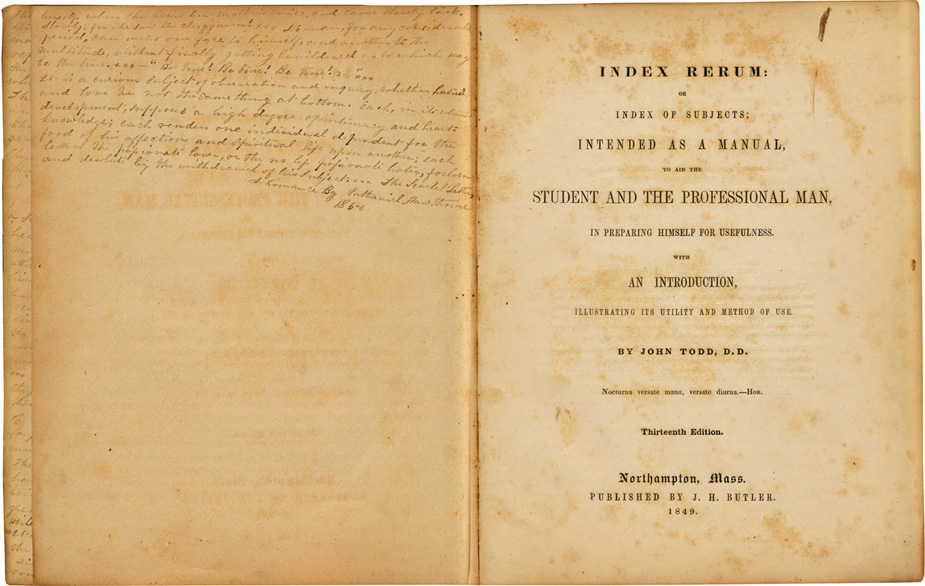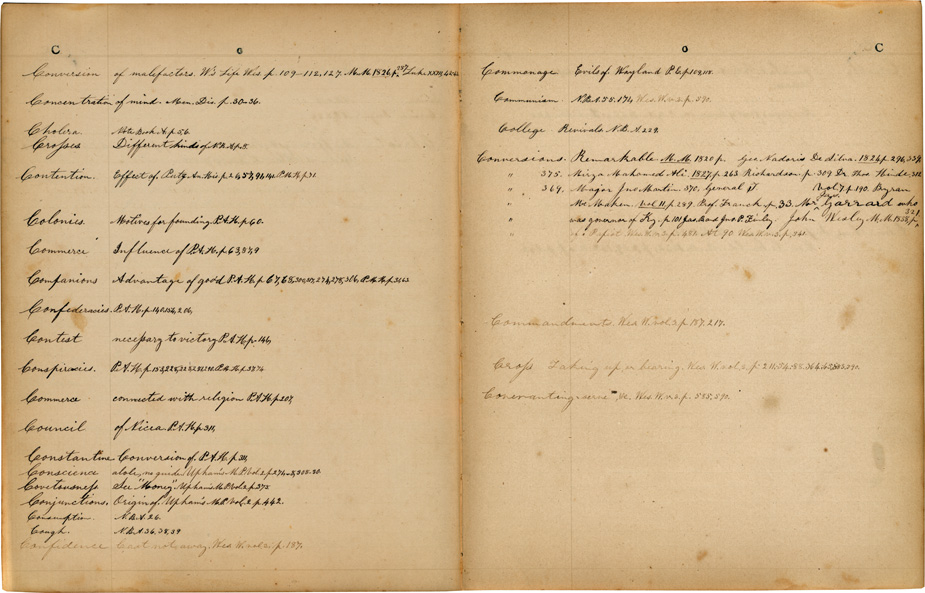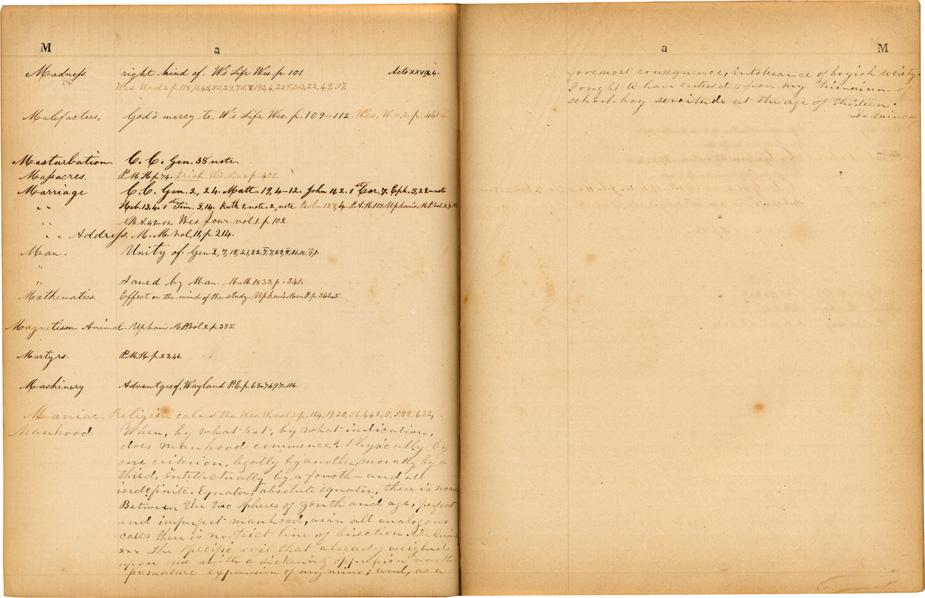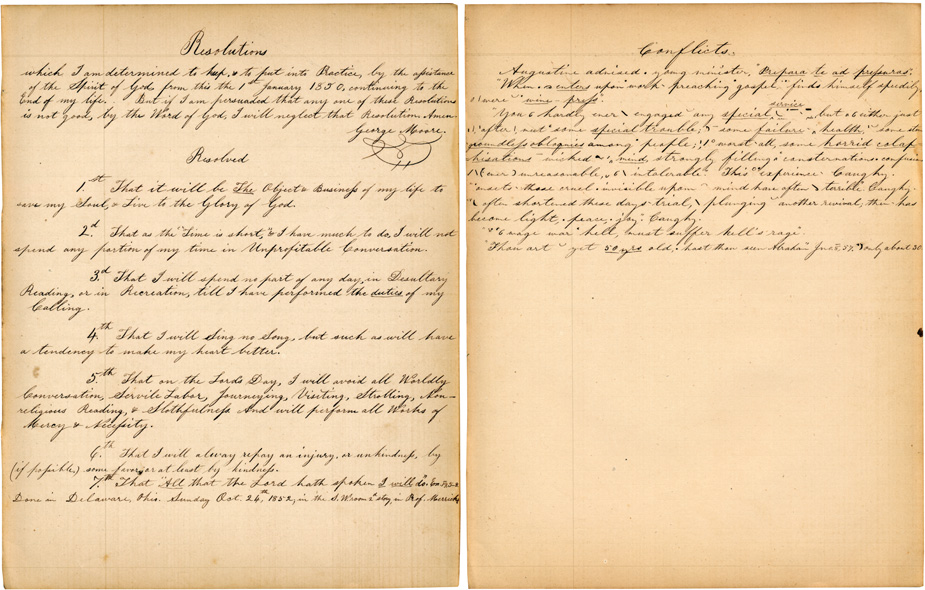The owner/user of this copy appears to have been one George Edin Moore, with some late entries possibly in a second and even third hand. My evidence is a series of seven resolutions
written in the volume immediately following pages ZuuZ, signed by George Moore and concluding: Done in Delaware, Ohio. Sunday Oct 24th, 1852, in the S. W. room 2d story, in Prof. Merrick
(where the passage cuts off). A George Edin Moore is listed in the Catalogue of the Ohio Wesleyan University for the Academical Year 1860-61 (Delaware, Ohio) here. The president of that institution was Rev Frederick Merrick, Professor of Belles-Lettres.
Of the several copies of Todd’s Index Rerum I have examined, this one evidences the most methodical and persistent usage. The citations are to a dozen or so titles — some books, some journals. It examples an intensive reading, but one focused on moral exempla, in history and elsewhere. DeQuincey and Nathaniel Hawthorne seem to be favored non-religious authors. Here is an overview of Moore’s copy:
- three pages of transcription from Hawthorne’s Scarlet Letter (20 separate passages in all, plus a single observation by Moore);
I have copied and confirmed this transcriptions against Hawthorne’s text, and may add them here, later. - the printed prefatory matter found in all editions of John Todd’s Index Rerum;
- the entries themselves, generally following the examples given by Todd, but including a good number of extracts as well, some of these latter in a second and even third hand;
Resolutions
here;- two pages of additional prayerful resolutions;
- a single page (half filled) headed
Conflicts
and consisting of extracts from Augustine and scripture; - a single page, containing a single quotation from Prof. Franck, under the heading
Faith;
- four pages of extracts under the heading
Christian Perfection;
and - two pages, set up in tabular form, with entries under the heading
Noted Orphan Houses.
Several items are laid loose in the volume: a pin (or nail), 1 1/8 inches long, at EooE; a flower at FuuF; a flower at HuuH; a newspaper clipping (cure for dyspepsia, and a joke at the expense of an Irishman) at IaaI; a irregularly cut stiff sheet with a penciled passage from Wordsworth (A flock of sheep that leisurely
) on one side, and the penciled note 5 swarms / 8 hives / $30
on the other, at LuuL; and a flower at TaaT. I will endeavor to identify the flowers.

sources
These are among the sources encountered :- Rev. Davis W. Clark. (George Peck, editor). Mental Discipline, with reference to the Acquisition and Communication of Knowledge, and to Education Generally, to which is appended A Topical Course of Theological Study. New-York: Published by Lane & Tippet for the Methodist Episcopal Church, 1847 here
- Thomas DeQuincey (1785-1859), e.g., A Sequel to the Confessions of an English Opium-Eater
- Edward Gibbon (1737-94). The Decline and Fall of the Roman Empire (1776-88, edition not identified)
- Nathaniel Hawthorne. The Scarlet Letter, A romance (1850; cited once only, in addition to three pages of transcription on front end and fly leaves)
- Homer’s Iliad, Pope translation.
- The Methodist Magazine and Quarterly Review (referred to by MM and MQR)
- Wilhelm Pütz. Manual of Ancient Geography and History (American edn, 1849) here
- Thomas C Upham. Elements of Mental Philosophy (1841) vol 1 and vol 2
Upham taught at Bowdoin, where Nathaniel Hawthorne was one of his students. - Francis Wayland. The Elements of Political Economy (1856 and subsequent editions, but edition Moore used is not certain) here
- John Wesley. The Works of the Reverend John Wesley (the seven volume American edition of 1840). Most frequently cited are volumes 3 and 4.
- Rev. James White. The History of France from the Earliest Times to mdcccxlviii. (1859, and numerous later printings, including the 1874 edition that matches citations in this volume, and that is available via Google Books) here
I have confirmed the preceding sources by checking citations (extract or topic, and page number if available) with copies available on Google Book or Internet Archive.
- CC (preceding references to scripture)
- N.B.
- N.B.A., also
Note Book A
— possibly his own (college) notebook? - P.A.H.
- P.M.H.
Indexing scholar/historian/practitioner Hazel K. Bell (aka KayCliff) makes a few general observations on nineteenth century indexing practice, in her LibraryThing review of George Gissing (1857-1903) his The Private Papers of Henry Ryecroft (1903). (See that review here.) Among her comments is this: in his index to that novel, Gissing gives only a single page number to an entry, where a topic might be treated in subsequent pages. Moore provides a different picture of indexing practice by giving long strings of page numbers to many of his entries; moreover, he concludes those strings with a comma, leaving room for additions as they are encountered in his reading.
I have not yet identified Moore, apart from the Ohio Wesleyan University connection.
CooC

| Conversion | of malefactors. W’s Life Wes. p. 109-112, 127. M.M. 1826, p. 257, Luke XXIII, 42-43 |
| Concentration | of mind. Men. Dis. p. 30-36 |
| Cholera | Note Book A. p. 5, 6. |
| Crosses | Different kinds of. N.B.A. p.8 |
| Contention | Effect of. Pütz An. His. p. 2, 6, 57, 91, 1441, P.M.H. p. 71. |
| Colonies | Motives for founding. P.A.H. p. 60. |
| Commerce | Influence of P.A.H. p. 63, 87, 9, |
| Companions | Advantage of good. P.A.H. p. 6, 7, 68, 300, 317, 274, 278, 306, P..M.H. p. 31, 63., |
| Confederacies | P.A.H. p. 140, 154, 206 |
| Contest | necessary to victory, P.A.H. p. 144, |
| Conspiracies | P.A.H. p. 153, 228, 228, 281, 290. P.M.H. p. 37, 74 |
| Commerce | connected with religion P.A.H. p. 207, |
| Council | of Nicea. P.A.H. p. 311 |
| Constantine | Conversion of. P.A.H. o 311, |
| Conscience | alone, no guide. Upham’s M.P. vol. 2. p. 274-8, 308-30 |
| Covetousness | see Money.Upham’s M.P. vol. 2. p. 375. |
| Conjunctions | Origin of. Upham’s M.P. vol. 2. p. 442. |
| Consumption | N.B.A. 26 |
| Cough | N.B.A. 36, 38, 39 |
| Confidence | Cast not away. Wes. W. vol. 3, p. 187 |
| Commonage | Evils of. Wayland P.E. p. 109, 118 |
| Communism | N.B.A. 55, 175, Wes. W. v.3p. 590 |
| College | Revivals. N.B.A. 229 |
| Conversions | remarkable. M.M. 1820 p. Geo. Nadoris DeSilva. 1824 p. 296, 339, 375. Mirza Mahamed Ali. 1827, p. 263. Richardson. p. 309. Dr. Thos. Hinde, 312, 369, Marjo Jno Martin. 370, General T. vol. 7, p. 190. Byran McMaken. vol. II, p. 289, Prof. Franck. p. 33, Mr. Jas. Garrard who was governor of Ky. p. 101 Jas. B. and Jno P. Finley. John Wesley M.M. 1838, p. 321.of Papist. Wes. W. v. 3. p. 481, At. 90 Wes. W. vo. 3. p. 541 |
| Commandments | Wes. W. vol.3.p.187, 217 |
| Crops | taking up, or bearing. Wes. W. vol.3,p. 211, -54, -88, 364, -65, 583, 590. |
| Covenanting | serve, &c. Wes. W.v.3.p. 585, 590 |
MaaM

| Madness | right kind of. W’s Life Wes. p. 101. Acts xxvi, 2,4 |
| Wes. W. vol 3. p. 118, 31, 45, 53, 59, 75, 8, 193, 4, 258, 313, 22, 49, 57 | |
| Malefactors | God’s mercy to. W’s Life Wes. p. 109-112. Wes. W. v. 3. p. 441-44 |
| Masturbation | C.C. Gen. 38 note. |
| Massacres | P.M.H. p. 74. Irish Wes. W. v. 3. p. 405 |
| Marriage | C.C. Gen. 2, 24. Matt. 19, 4-12. John 11, 2. 1st Cor. 7. Eph. 5,22-note |
| Heb. 13,4. 1st Tim. 5,14. Ruth 1, note. 2, note. Psalm 127,4. P.A.H. 115. Upham’s M.P. vol. 2. p. 197 | |
| N.B.A. 4-52. Wes. Jour. vol. 1. p 102 | |
| Address. M.M. vol. II, p. 214. | |
| Man | Unity of. Gen 2, 7, 18, 21, 2, 7, 7, 29, 8, 16, 18, 9, 1 [see superscripted lines above selected page numbers, in mss.] |
| Saved by Man. M.M. 1838, p. 341. | |
| Mathematics | Effect on the mind of the study. Upham’s M.P. p. 362-5 |
| Magnetism | Animal. Upham’s M.P. vol 2 p. 385 |
| Martyrs | P.M.H. p. 23, 46 |
| Machinery | Advantages of. Wayland P.E. p. 68-74. 97-104 |
| Manhood | When, by what test, by what indication, does manhood commence? Physically by one criterion, legally by another, morally by a third, mentally by a fourth,— and all indefinite. Equator, absolute equator, there is none. Between the two spheres of youth and age, perfect and imperfect manhood, as in all analogous cases, there is no strict line of bisection. DeQuincey |
| [And] the specific evil that already weighed upon me with a sickening oppression was the premature expansion of my mind; and, as a foremost consequence, intolerance of boyish society. I ought to have entered upon my triennium of school-boy servitude at the age of thirteen. DeQuincey |
resolutions

Resolutions
which I am determined to keep, & to put into Practice, by the assistance of the Spirit of God, from this the 1st January 1850, continuing to the end of my life. But if I am persuaded that any one of these Resolutions is not good, by the Word of God, I will neglect that Resolution. Amen
George Moore.
Resolved
1.st That it will be The Object & Business in my life to save my Soul, & life to the Glory of God.
2.d That as the Time is short,
& I have much to do, I will not spend any portion of my time in Unprofitable Conversation.
3.d That I will spend no part of any day, in Desultory Reading, or in Recreation, till I have performed the duties of my Calling.
4.th That I will Sing no Song, but such as will have a tendency to make my heart better.
5.th That on the Lord’s Day, I will avoid all Worldly Conversation, Servile Labor, Journeying, Visiting, Strolling, Non-religious Reading, & Slothfulness. And will perform all Works of Mercy & Necessity.
6.th That I will always repay an injury, or unkindness, by (if possible) some favor; or at least by some kindness.
7.th That All that the Lord hath spoken I will do.
Ex. 19, 5-8.
Done in Delaware, Ohio. Sunday, Oct. 24th, 1852; in the S. W. room, 2d story, in Prof. Merrick’s
These Resolutions
are followed by two pages of what I call prayerful resolutions
(dated March 21st, 1855), and then the passage headed Conflicts
(above right). Both of the latter sections contain a number of stenographic marks, that might be interpreted by reference to the transcribed passages in Augustine.
Thanks to Ken Haverly of Meetinghouse Books for bringing this volume to my attention.